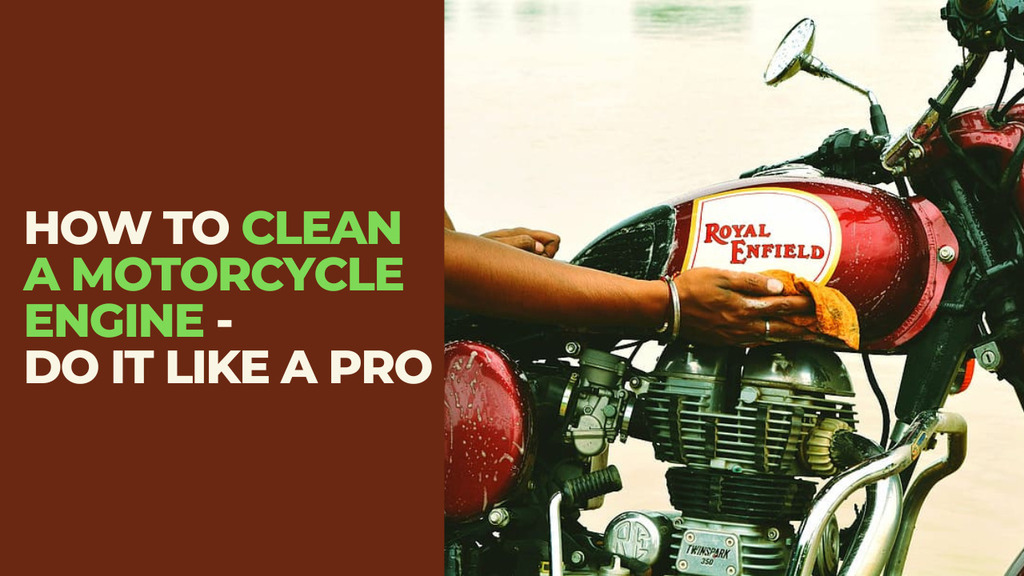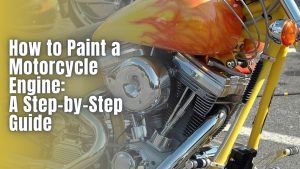Have you ever taken a look under the hood of your bike and cringed at all the grime clinging to the engine? Yeah, been there. Cleaning that puppy is crucial to keep it running smooth. A dirty motor can cause all sorts of issues down the line like reduced power and accelerated wear.
So it’s time to roll up the sleeves and get your hands dirty. With the right supplies and techniques, your steed will be purring like new in no time. I’ll walk you through everything you need to know about how to clean a motorcycle engine like a pro. Let’s get started!
Preparation for Cleaning a Motorcycle Engine
Have you ever started a big job around the house only to realize you’re missing that one weird screwdriver? No bueno, am I right? Save yourself the hassle and put together a kit with all the stuff your engine will need to get shipshape.
a. Gathering supplies
Before you get to scrubbing, it’s important to gather all the essentials. Some of the basics to include are:
- Microfiber cloths for drying
- A plastic scraper for stubborn gunk
- A toothbrush for tight spaces
- Latex gloves so you don’t ruin your manicure
- Safety goggles (you don’t want degreaser in your peepers!)
- A specialty degreasing spray
I like to keep my kit in the garage so it’s ready whenever my motor starts looking thirsty.
b. Recommended cleaning tools and products
While simple green or dish soap would work in a pinch, using the proper cleaning agents formulated for bike engines will make your life much easier.
Degreasers cut through grease better than general cleaners, and finned surfaces need an abrasive that won’t damage delicate metal.
Some offerings from the motorcycle supply shop include citrus-based degreasers that smell a lot better than acetone, antimicrobial soaps to fight gunky bacteria, and titanium wheel cleaners for extra stubborn brakes.
| CLEANING ITEMS | PURPOSE |
|---|---|
| Soft plastic scraper | Removing caked-on dirt, grime, and debris from crevices and surfaces |
| Microfiber cloths | Drying and polishing surfaces without scratching |
| Latex gloves | Protecting hands from harsh chemicals and preventing grease/grime from getting under nails |
| Safety goggles | Shielding eyes from flying debris and splashing liquids |
| Toothbrush | Scrubbing tight spaces like between fins |
| Citrus degreaser | Cutting through and emulsifying grease, oil, and other sticky residues |
| Antimicrobial soap | Fighting bacteria, mildew, and odors caused by neglected cleaning |
| Titanium wheel cleaner | Safely removing brake dust and other bonded dirt from rims, calipers, and other finned components |
| Spray bottle | Applying cleaning solutions evenly and selectively where needed |
c. Preparing the engine area
Now that you’ve got your toolkit together, it’s time to find a good spot to do the deed. You’ll want somewhere with decent natural light so you can see what you’re doing, and with a surface you don’t mind getting a little greasy – an old tarp or your trusty garage floor will do the trick.
It also helps to have a source of running water nearby to rinse your brushes and such, so a hose attachment is ideal. No workspace? No sweat – even just parking your bike out in the driveway will work in a pinch!
d. Letting the engine cool completely
Revving your motor to the redline and beginning scrubbing seconds later is never a good look, my friend. Before you even think about lathering up those pistons, give your engine plenty of time to cool down.
We’re talking letting it sit for an hour or more after your last ride. No use risking third degree burns on your knuckles! Patience is key here.
Pop the hood, crack a beer, and relax while the temps drop to a safe level before getting those hands dirty.
SEE MORE: Everything About Motorcycle Carburetor Choke Cleaning
e. Protecting sensitive components
Not all parts of the engine are meant for a soap sudsy scrub down. Before you start slinging cleaning solutions everywhere, it’s a good idea to cover up any delicate doodads that don’t want a bath.
Stuff like spark plugs, wiring harnesses, computer modules – you name it. Nothing ruins a good clean like accidentally dousing your bike’s brain in degreaser, am I right?
Take some plastic bags, vinyl gloves, or aluminum foil and fashion them over areas you don’t want soaking wet. The air box, exhaust pipes, and other openings can also be masked off.
Ask a buddy to help you identify parts to protect if you’re not sure. Better to miss a spot with grime than damage something you’ll have to replace.
How to Clean a Motorcycle Engine: The Complete Guide
1. Removing Loose Dirt and Debris
Before you start scrub-a-dub-dubbing, it’s a good idea to blast away any grime that isn’t glued on there for dear life. This is where compressed air comes in handy.
Give a few good poots all around nooks and crannies to dislodge crumbs and flakey filth. Make sure to hold components steady so you don’t accidentally knock any sensors or doodads askew.
A small air compressor or canned air will get the job done. Just be careful not to use so much pressure that you damage any seals or gaskets.
After blasting, take a critical look at the engine. Any spots still caked in stubborn gunk? Circle back with a plastic scraper to remove the tough stuff before progressing to the next step.
2. Applying Degreaser
- Choose a suitable degreaser
- Spray degreaser on greasy areas
- Allow it to soak for recommended time
Choosing a suitable degreaser
Using a degreaser formulated for car engines will work much better than household cleaners. Look for a citrus-based option that cuts grease yet smells better than acetone fumes.
Applied correctly, degreaser turns that caked-on gunk into an oil slick that rinses away with ease.
Spraying degreaser on greasy areas
With degreaser in hand, give er a good spritz all over visibly dirty areas. Really soak it on thickly where crud clings the toughest.
No need to douse the whole engine yet – you can always reapply more later. Allowing it to dwell helps it to deeply penetrate and loosen grime.
Allowing it to soak for recommended time
Now comes the waiting game. Resist the urge to dig in early! Follow product instructions for soak time – usually 5-10 minutes does the trick.
Use this break to grab another cold one from the fridge. The degreaser’s potent chemicals need time to work their magic before scrubbing.
SEE MORE: The Best Motorcycle Engine Degreaser to Maximize Performance
3. Scrubbing and Washing
- Use a soft brush on difficult areas
- Thoroughly scrub with soapy water
- Focus on greasy/dirty spots
Using a soft brush on difficult areas
Time to step it up from degreaser alone. Grab your rusty scrub brush and get those engines fins sanded clean.
Focus the brush on crud crammed into tight corners that degreaser couldn’t reach, like crevices around the cylinders. Use gentle pressure – you’re loosening crud, not stripping paint.
Thoroughly scrubbing with soapy water
Once degreaser has done its work, it’s time for the main event. Lather up your trusty green scrubbie with bike wash soap and scrub every nook and cranny until bubbles form.
Don’t be shy – put some muscle into it! This one’s gonna get your hands dirtier than a pit stop.
Focusing on greasy/dirty spots
When scrubbing, pay extra attention to places that gathered the most guck, like the heads, valve covers and oil drippers. These sticky suckers will take some serious scouring to get showroom shiny. Don’t stop until all grime goes down the drain!
4. Rinsing
- Thoroughly rinse with clean water
- Ensure all cleaning agents are removed
Thoroughly rinsing with clean water
Now it’s time to wash away all that filthy sudsiness. Attach your hose and give er a good thorough rinse all over, paying extra attention to any crevices lingering soap suds.
Use plenty of pressure – you want to blast off every last grimy residue so she’s squeaky clean.
Ensuring all cleaning agents are removed
Take your time inspecting every nook and cranny to ensure all degreaser and soap is rinsed away. Traces can attract more dirt over time.
Do a final rinse with the engine running to flush out hidden areas. No sense ruining all that hard work with leftover chemicals!
With a final once-over, you’ve now removed all the muck revealing shiny fresh parts underneath. She’s looking brand spanking new! One more step stands between you and smooth sailing – drying her off.
5. Drying
- Use compressed air or cloths to dry
- Apply polish or protectant (optional)
Using compressed air or cloths to dry
Now it’s time to finish drying her off! Blast away remaining droplets with compressed air, aiming into small crevices.
Then buff out excess moisture from flat surfaces using a microfiber cloth. No need to rub too hard – these cloths are super absorbent.
You can use a leaf blower too:
Applying polish or protectant (optional)
Once fully dry, you may want to apply a little strutting polish to bring out that deep shine, especially on chrome trim.
Or treat her to a protective coat of natural wax to guard against water spots. Not required, but a nice way to finish her off with some pizzazz!
There you have it – your machine is now fresher than a morning dew. Fire her up and feel the power with none of that gunk holding her back.
6. Cleaning Engine Fins (if applicable)
Those thin metal fins that help cool the engine require a light touch. Degreaser alone may not do the trick for baked-on grime. A more gentle approach works best here.
Pour white vinegar or a dedicated fin cleaner onto a soft toothbrush. The acids help cut through grease without scrubbing too roughly. Gently brush along the Direction of the fins, being careful not to bend them. Let it sit a few minutes before rinsing thoroughly.
Fins can be delicate, so go slowly and check for progress often. Repeated soaking and scrubbing should restore them to like-new without any damage. A clean set of fins allows optimum heat transfer to keep your engine running smooth.
With fins taken care of, your ride’s whole cooling system can breathe easy. Time to fire it up and hit the road!
SEE MORE: How to Clean a Motorcycle Carburetor Without Removing
Maintenance Tips to Keep the Engine Clean
- Regular checks and quick cleanings
- Choose a protectant or cover
Don’t let things get grimy again! Check your engine bay after long touring days and blast away loose debris. Catching dust bunnies early means less scrubbing later.
For machines sitting periods, apply a coat of weather-resistant protectant to sustain that shine. Or cover her up cozy with a breathable cover to lock out dust. Either protects without trapping moisture that could breed surface rust.
With a little TLC, your engine can stay fresh between deep cleans. Maintenance will keep her performing at peak levels.
Safety Considerations
- Protective equipment like gloves and goggles
- Working in a well-ventilated area
- Avoiding smoking
I mentioned gloves before, but it’s worth repeating – protective gear is non-negotiable when cleaning your ride. Goggles prevent nasty chemical splashes, and gloves save your mittens from rough degreaser.
Also, fresh air is important when using toxic chemicals. Either work outside or crack open the garage door. Fumes from some degreasers and thinners can knock you on your keister, so breathe easy.
Avoiding smoking. This should go without saying, but some rules were made to be broken. So as a friendly reminder – no lighting up around flammables! Degreaser vapors are no joke. Wait till the job is done and you’re fueling back up at the bar, cowboy.
Be smart, be safe. The whole point is having a kickass bike, not a kick in the pants from chlorinated grime. Take the proper precautions and stay shiny, my friends!
Season-Specific Bike Engine Cleaning Tips
Summer Tips
Nothing beats riding with the warm breeze in your hair. But summer heat means bugs on the front end and more frequent cleanings.
Get in the habit of a quick wipe down after hard rides to prevent baked-on bug splats.
Winter Tips
Roadsalty from winter tires is murder on metal. Rinse your ride thoroughly after sloppy rides to prevent corrosion from road grime.
Carbon buildup also tends to be worse in colder months from heavier throttling – so open her up occasionally to blow those cobwebs out!
Tips for Weathered Areas
Give spots that take a pounding, like the front fairing, an extra once over. Road grime and bugs work their way into every crevice over time. Don’t forget these weathered zones when degreasing and scrubbing.
No matter the season, your ride’s engine relies on cleanliness to stay in shape. Tweak your routine based on changing conditions so she’s ready when you are.
FAQs About Motorcycle Engine Cleaning
Can I use household cleaners instead of specialty degreaser?
While general cleaning products can help remove surface dirt, commercial degreaser is recommended for stubborn grease and grime. Household cleaners aren’t as tough and may not fully dissolve oils. Degreaser is also less harsh on components.
How often should I clean my engine?
It depends on how often you ride and weather conditions. A deep clean every season or 500 miles is a good guideline. In extreme heat or winter salt, clean more frequently. Regular quick wipedowns prevent buildup between deep cleans.
Can I clean my engine while it’s hot?
No, never clean a hot engine. Give it time to fully cool down first to avoid burns. Hot surfaces and cooling fan can also damage cleaning products. Wait until safe to touch before starting your clean.
Will compressed air damage anything?
Use moderate pressure and hold components securely when blowing with compressed air. Be very gentle around seals, gaskets and sensors. High pressure risks tearing seals or knocking sensors loose. Low pressure is safer for all blowing tasks.
How long will my engine stay clean after cleaning?
With regular maintenance, your engine can stay remarkably clean between services. But extreme weather, dirt roads or busy riding means more frequent touch-ups. Quick wipedowns after each long ride help delay deeper cleaning needs.


![Read more about the article How to Measure Motorcycle Handlebar Diameter [For the Perfect Fit]](https://www.motozmo.com/wp-content/uploads/2023/11/motorcycle-handlebar-300x169.jpg)

